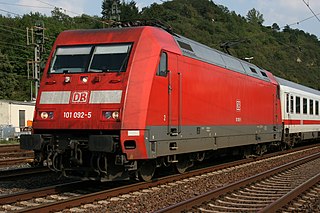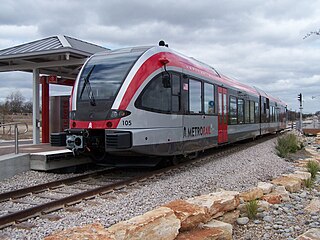
The Hamburg S-Bahn is a rapid transit railway system in the Hamburg Metropolitan Region. Together, the S-Bahn, the Hamburg U-Bahn, the AKN railway and the regional railway form the backbone of railway public transport in the city and the surrounding area. The network has operated since 1907 as a commuter rail system, under the direction of the state railway, and is a member of the Hamburger Verkehrsverbund. There are four lines, serving 68 stations, on 147 kilometres (91 mi) of route. On an average working day the S-Bahn transports about 590,000 passengers; in 2010 about 221 million people used the S-Bahn.

The DB Class 101 is a class of three-phase electric locomotives built by Adtranz and operated by DB Fernverkehr in Germany. 145 locomotives were built between 1996 and 1999 to replace the 30-year-old and aging Class 103 as the flagship of the Deutsche Bahn, primarily hauling Intercity services. This class encompasses the latest generation of locomotives of the Deutsche Bahn.

Alstom Traxx is a modular product platform of mainline diesel-electric and electric locomotives. It was produced originally by Bombardier Transportation and later Alstom, and was built in both freight and passenger variants. The first version was a dual-voltage AC locomotive built for German railways from the year 2000. Later types included DC versions, as well as quadruple-voltage machines, able to operate on most European electrification schemes: 1.5/3.0 kV DC and 15/25 kV AC. The family was expanded in 2006 to include diesel-powered versions. Elements common to all variants include steel bodyshells, two bogies with two powered axles each, three-phase asynchronous induction motors, cooling exhausts on the roof edges, and wheel disc brakes.

The Alstom Coradia LINT is an articulated railcar of the Alstom Coradia family manufactured by Alstom since 1999, offered in diesel and hydrogen fuel models. The acronym LINT is short for the German "leichter innovativer Nahverkehrstriebwagen". It was designed by Linke-Hofmann-Busch and has been distributed as part of Alstom's Coradia family.

The Deutsche Bahn Class 423 EMU is a light-weight articulated electric railcar for S-Bahn commuter networks in Germany. The train has similar dimensions to its predecessor, the Class 420 EMU, but is significantly lighter and has one large passenger compartment, while that of the 420 is divided into three parts. The 423 additionally has six doors in each carriage, which is down from eight on the 420. They are numbered from 423 001 to 423 462.

The Stadler GTW is an articulated railcar for local transport made by Stadler Rail of Switzerland. GTW stands for Gelenktriebwagen.

The DRG Class SVT 877Hamburg Flyer – sometimes also Flying Hamburger or in German Fliegender Hamburger – was Germany's first fast diesel train, and is credited with establishing the fastest regular railway connection in the world in its time. Correctly named the Baureihe SVT 877, the diesel-electric powered train was used to carry passengers on the Berlin–Hamburg line. It entered service in 1933.

Barmbek is a railway station and transport hub in Hamburg, Germany, for the underground railway (U-Bahn) system and the suburban railway (S-Bahn) system. The station is located in the district of Barmbek-Nord, Germany. Barmbek-Nord is part of the borough of Hamburg-Nord.

An Ausbesserungswerk is a railway facility in German-speaking countries, the primary function of which is the repair of railway vehicles or their components. It is thus equivalent to a 'repair shop' or 'works'. It is also referred to as a Centralwerkstatt or Zentralwerkstatt or Hauptwerkstatt. During the Deutsche Reichsbahn-Gesellschaft (DRG) period between the two world wars as well as the period of the Deutsche Reichsbahn in East Germany these facilities were called Reichsbahnausbesserungswerke.

The DB Class 215 is a 4 axle diesel locomotive of the V 160 type. They were built for the German Federal Railways for medium-weight passenger and freight service on secondary and primary routes, and later passed to the Deutsche Bahn AG.

The DB Class 218 are a class of 4-axle, diesel-hydraulic locomotives acquired by the Deutsche Bundesbahn for use on main and secondary lines for both passenger and freight trains.

The DB Class V 60 is a German diesel locomotive operated by the Deutsche Bundesbahn (DB) and later, the Deutsche Bahn AG, which is used particularly for shunting duties, but also for hauling light goods trains. Seventeen locomotives were bought used by the Norwegian State Railways and designated NSB Di 5. Also the Yugoslav Railways bought used units, and designated them JŽ 734; they were subsequently designated Series 2133 by the Croatian Railways.

The DR 130 family of locomotives comprises the DR Class 130, DR Class 131, DR Class 132 and DR Class 142, in USSR locomotive called TE109 and TE129.

The DBAG Class 145 and DBAG Class 146 are Bo′Bo′ mainline electric locomotives built by Adtranz primarily for the Deutsche Bahn at the end of the 1990s. The Class 145 is the freight version for DB Cargo; the Class 146 is the passenger version for DB Regio. Additional freight machines were built for the former Swiss railway Mittelthurgaubahn as well as for various private operators and leasing companies.

Ohlsdorf is a railway station in Hamburg, Germany, located at the junction of the Hamburg-Altona link line with the Alster Valley line and the Hamburg Airport line in Ohlsdorf, Hamburg near the Ohlsdorf Cemetery.

The DRG Class ET 171 was a three-car electric multiple unit built for the S-Bahn Hamburg.

128 001, as registered at Deutsche Bahn, or 12X, as named by its manufacturer AEG Schienenfahrzeuge and its successive owners ADtranz and Bombardier Transportation, is an experimental high-performance electric locomotive built in 1994, which was operated as testbed and test locomotive until 2010. The design of the locomotive featured several technological innovations, including power electronics using new types of semiconductors and water cooling, a new final drive concept, a new bogie concept, and protruding windflaps for improved aerodynamics that gave the locomotive a unique look.

The Sieg Railway (German: Siegstrecke is a 100-kilometre long, electrified German main line railway between Cologne-Deutz via Porz, Troisdorf, Siegburg, Hennef, Au, Betzdorf to Siegen with a through service to Cologne Hauptbahnhof. Although most of it is two-track, two five-kilometre sections are only single track. Both ends of the line are in the state of North Rhine-Westphalia, but between Au and Niederschelden it runs through Rhineland-Palatinate. It is one of the oldest lines in Germany, opened between 1859 and 1862 by the Cologne-Minden Railway Company.

The DR Class V 100, redesignated the Class 110 in 1970, was a four-axled diesel locomotive for medium duties operated by the Deutsche Reichsbahn of East Germany. Locomotives of the type were also supplied to railways in China and Czechoslovakia and to various industrial operators.

The VAG Class DT2 is an electric multiple unit (EMU) train type operated by the Verkehrs-Aktiengesellschaft Nürnberg on the Nuremberg U-Bahn system. It is a derivative of the MVG Class B, in service on the Munich U-Bahn since 1981.




























